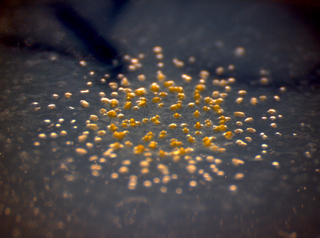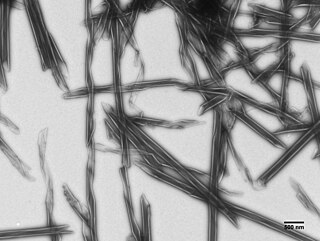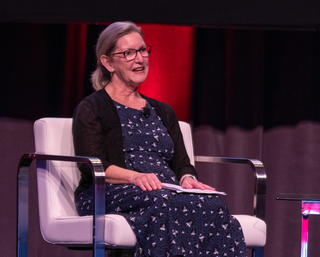Related Research Articles

Selman Abraham Waksman was a Jewish American inventor, Nobel Prize laureate, biochemist and microbiologist whose research into the decomposition of organisms that live in soil enabled the discovery of streptomycin and several other antibiotics. A professor of biochemistry and microbiology at Rutgers University for four decades, he discovered several antibiotics, and he introduced procedures that have led to the development of many others. The proceeds earned from the licensing of his patents funded a foundation for microbiological research, which established the Waksman Institute of Microbiology located at the Rutgers University Busch Campus in Piscataway, New Jersey (USA). In 1952, he was awarded the Nobel Prize in Physiology or Medicine for "ingenious, systematic, and successful studies of the soil microbes that led to the discovery of streptomycin." Waksman and his foundation later were sued by Albert Schatz, one of his Ph.D. students and the discoverer of streptomycin, for minimizing Schatz's role in the discovery.

Stanley "Stan" Falkow was an American microbiologist and a professor of microbiology at Georgetown University, University of Washington, and Stanford University School of Medicine. Falkow is known as the father of the field of molecular microbial pathogenesis. He formulated molecular Koch's postulates, which have guided the study of the microbial determinants of infectious diseases since the late 1980s. Falkow spent over 50 years uncovering molecular mechanisms of how bacteria cause disease and how to disarm them. Falkow also was one of the first scientists to investigate antimicrobial resistance, and presented his research extensively to scientific, government, and lay audiences explaining the spread of resistance from one organism to another, now known as horizontal gene transfer, and the implications of this phenomenon on our ability to combat infections in the future.
Thermus thermophilus is a Gram-negative bacterium used in a range of biotechnological applications, including as a model organism for genetic manipulation, structural genomics, and systems biology. The bacterium is extremely thermophilic, with an optimal growth temperature of about 65 °C (149 °F). Thermus thermophilus was originally isolated from a thermal vent within a hot spring in Izu, Japan by Tairo Oshima and Kazutomo Imahori. The organism has also been found to be important in the degradation of organic materials in the thermogenic phase of composting. T. thermophilus is classified into several strains, of which HB8 and HB27 are the most commonly used in laboratory environments. Genome analyses of these strains were independently completed in 2004. Thermus also displays the highest frequencies of natural transformation known to date.

Myxococcus xanthus is a gram-negative, bacillus species of myxobacteria that is typically found in the top-most layer of soil. These bacteria lack flagella; rather, they use pili for motility. M. xanthus is well-known for its predatory behavior on other microorganisms. These bacteria source carbon from lipids rather than sugars. They exhibit various forms of self-organizing behavior in response to environmental cues. Under normal conditions with abundant food, they exist as predatory, saprophytic single-species biofilm called a swarm, highlighting the importance of intercellular communication for these bacteria. Under starvation conditions, they undergo a multicellular development cycle.

Swarming motility is a rapid and coordinated translocation of a bacterial population across solid or semi-solid surfaces, and is an example of bacterial multicellularity and swarm behaviour. Swarming motility was first reported by Jorgen Henrichsen and has been mostly studied in genus Serratia, Salmonella, Aeromonas, Bacillus, Yersinia, Pseudomonas, Proteus, Vibrio and Escherichia.
Roberto Kolter is Professor of Microbiology, Emeritus at Harvard Medical School, an author, and past president of the American Society for Microbiology. Kolter has been a professor at Harvard Medical School since 1983 and was Co-director of Harvard's Microbial Sciences Initiative from 2003-2018. During the 35-year term of the Kolter laboratory from 1983 to 2018, more than 130 graduate students and postdoctoral trainees explored an eclectic mix of topics gravitating around the study of microbes. Kolter is a fellow of the American Association for the Advancement of Science and of the American Academy of Microbiology.
Thauera aromatica is a species of bacteria. Its type strain is K 172T.
Azoarcus evansii is a species of bacteria. Its type strain is KB 740T.
Roseovarius nubinhibens is a species of Gram-negative, rod-shaped, aerobic dimethylsulfoniopropionate-demethylating bacteria. Its type strain is ISMT.
Methylophaga marina is an obligately methylotrophic, Gram-negative, strictly aerobic, motile, rod-shaped bacteria, the type species of its genus. Its type strain is ATCC 35842.
Methylophaga thalassica is an obligately methylotrophic, Gram-negative, strictly aerobic, motile, rod-shaped bacteria. Its type strain is ATCC 33146.

Streptomyces antibioticus is a gram-positive bacterium discovered in 1941 by Nobel-prize-winner Selman Waksman and H. Boyd Woodruff. Its name is derived from the Greek "strepto-" meaning "twisted", alluding to this genus' chain-like spore production, and "antibioticus", referring to this species' extensive antibiotic production. Upon its first characterization, it was noted that S. antibioticus produces a distinct soil odor.
The Brachyspira holin (B-Hol) Family consists of several proteins from the GTA holin of Brachyspira hyodysenteriae, which facilitates gene transfer agent-release to VSH-1 holin of Brachyspira pilosicoli. VSH-1 is thought to participate in cell lysis. These proteins range in size from about 85 to 145 amino acyl residues (aas) and exhibit between 2 and 4 transmembrane segments (TMSs). A representative list of proteins belonging to the B-Hol family can be found in the Transporter Classification Database.

R bodies are polymeric protein inclusions formed inside the cytoplasm of bacteria. Initially discovered in kappa particles, bacterial endosymbionts of the ciliate Paramecium, R bodies have since been discovered in a variety of taxa.

Elizabeth Bugie Gregory was an American biochemist who co-discovered Streptomycin, the first antibiotic against Mycobacterium tuberculosis in Selman Waksman laboratory at Rutgers University. Waksman went on to win the Nobel Prize for Medicine in 1952 and took the credit for the discovery.
In bacteriology, minicells are bacterial cells that are smaller than usual. The first minicells reported were from a strain of Escherichia coli that had a mutation in the Min System that lead to mis-localization of the septum during cell division and the production of cells of random sizes.
Catherine Louise Kearney Squires was a microbiologist known for her work on ribosomal RNA using Escherichia coli as a model organism. She was an elected fellow of the American Academy of Microbiology and the American Association for the Advancement of Science.

Virginia L. Miller is a microbiologist known for her work on studying the factors leading to disease caused by bacteria. Miller is an elected fellow of the American Academy of Microbiology (2003) and a former Pew Charitable Trust Biomedical Scholar (1989).
Robert Lyman Starkey was an American microbiologist. He was the president of the American Society for Microbiology in 1963.
Richard P. Novick is an American microbiologist best known for his work in the fields of plasmid biology, staphylococcal pathobiology and antimicrobial resistance. He is the Recanati Family Professor of Science, Emeritus, at NYU Grossman School of Medicine and is a member of the American National Academy of Sciences. Novick has published over 250 peer-reviewed articles, and several book reviews for the Times Literary Supplement, and is a member of the Editorial Board of the Proceedings of the National Academy of Sciences.
References
- 1 2 3 4 "Dr. Hotchkiss is selected UK distinguished professor". The Lexington Herald. 1962-05-26. p. 1. Retrieved 2022-03-05.
- ↑ Hotchkiss, Margaret (1922). The influence of various salts upon the growth of bacterium communis (Thesis). New Haven, Conn.: Yale University. OCLC 83820136.
- 1 2 3 "Margaret Hotchkiss". Lexington Herald-Leader. 1965-05-09. p. 87. Retrieved 2022-03-05.
- ↑ "Appointment Listed". The Lexington Herald. 1946-06-05. p. 2. Retrieved 2022-03-05.
- ↑ "Chiropodists to elect today". The Lexington Herald. 1960-05-01. p. 2. Retrieved 2022-03-05.
- 1 2 "Dr. Hotchkiss". The Lexington Herald. 1962-05-26. p. 10. Retrieved 2022-03-05.
- ↑ "Dr. Hotchkiss to head bacteriology society". The Lexington Herald. 1948-10-26. p. 15. Retrieved 2022-03-05.
- 1 2 3 "Encourage students to face change, Dr. Hotchkiss says". The Lexington Herald. 1963-04-03. p. 15. Retrieved 2022-03-05.
- 1 2 "Dr. Hotchkiss, retiring, will continue research". Lexington Herald-Leader. 1964-01-20. p. 13. Retrieved 2022-03-05.
- ↑ "UK microbiologist says research work to continue". The Lexington Herald. 1964-01-20. p. 6. Retrieved 2022-03-05.
- ↑ Hotchkiss, Margaret (March 1923). "Studies on Salt Action Vi. The Stimulating and Inhibitive Effect of Certain Cations Upon Bacterial Growth". Journal of Bacteriology. 8 (2): 141–162. doi:10.1128/jb.8.2.141-162.1923. PMC 379008 . PMID 16558991.
- ↑ Waksman, Selman A.; Hotchkiss, Margaret (1937). "Viability of Bacteria in Sea Water". Journal of Bacteriology. 33 (4): 389–400. doi:10.1128/jb.33.4.389-400.1937. ISSN 0021-9193. PMC 545103 . PMID 16560007.
- ↑ Hotchkiss, Margaret; Waksman, Selman A. (1936). "Correlative Studies of Microscopic and Plate Methods for Evaluating the Bacterial Population of the Sea". Journal of Bacteriology. 32 (4): 423–432. doi:10.1128/jb.32.4.423-432.1936. ISSN 0021-9193. PMC 543808 . PMID 16559963.
- ↑ Waksman, Selman A.; Hotchkiss, Margaret; Carey, Cornelia L. (1 October 1933). "Marine bacteria and their role in the cycle of life in the sea: II. bacteria concerned in the cycle of nitrogen in the sea". The Biological Bulletin. 65 (2): 137–167. doi:10.2307/1537170. ISSN 0006-3185. JSTOR 1537170.<ref> In sediments, she examined how bacteria change organic matter into carbon dioxide. <ref>Waksman, Selman A.; Hotchkiss, Margaret (1937). "On the oxidation of organic matter in marine sediments by bacteria". Journal of Marine Research. 78 (3): 151–166. doi:10.1357/002224020834162176 (inactive 1 November 2024). S2CID 240184203.
{{cite journal}}: CS1 maint: DOI inactive as of November 2024 (link) - ↑ Hotchkiss, Margaret (1946). ZoBell, Claude E. (ed.). "Bacteria of the Ocean". The Scientific Monthly. 63 (3): 239–240. ISSN 0096-3771. JSTOR 18892.
- ↑ Hotchkiss, Margaret (1935). "Evidence on the Specificity of Hexosidases A Comparison of the Activity of Escherichia coli and Escherichia communior". Journal of Bacteriology. 29 (4): 391–398. doi:10.1128/jb.29.4.391-398.1935. ISSN 0021-9193. OCLC 9173572015. PMC 543607 . PMID 16559798.
- ↑ Hotchkiss, Margaret; Murray, T. J. (1923). "The Relative Prevalence of Bacteria in an Imhoff Tank". American Journal of Public Health. 13 (7): 562–567. doi:10.2105/AJPH.13.7.562. ISSN 0271-4353. PMC 1354529 . PMID 18010986.
- ↑ Hotchkiss, Margaret (1924). "Studies on the Biology of Sewage Disposal a Sprinkling Filter Bed and ITS Bacteriological Population". Journal of Bacteriology. 9 (5): 455–461. doi:10.1128/jb.9.5.455-461.1924. ISSN 0021-9193. OCLC 9173591982. PMC 379072 . PMID 16559061.
- ↑ Hotchkiss, Margaret (1931). Review of current dental literature; Presence of fusiform bacilli and spirochetes in mouths of a group of young adults. Philadelphia : : S.S. White Dental Manufacturing Co. OCLC 658038959.
- ↑ McClellan, James T.; Scherr, George H.; Hotchkiss, Margaret (1951). "A clinical, pathological, and mycological study of a fatal case of histoplasmosis in an infant". Mycopathologia et Mycologia Applicata. 6 (2): 86–91. doi:10.1007/BF02279181. ISSN 0301-486X. PMID 14941019. S2CID 35460355.
- ↑ Young, Barbara Burns; Hotchkiss, Margaret (1959-11-01). "Developmental morphology in the genus nocardia". Mycopathologia et Mycologia Applicata. 11 (4): 297–310. doi:10.1007/BF02089505. ISSN 1573-0832. PMID 13846606. S2CID 2900587.
- ↑ Edwards, O.F.; Hotchkiss, Margaret (1963). "DEVELOPMENTAL CYCLE OF AEROBIC ACTINOMYCTETES AS DEMONSTRATED IN ULTRATHIN SECTIONS". Journal of Applied Physics. 34 (8): 2528.
- ↑ Hotchkiss, Margaret; Edwards, O.F. (1958). "THE MORPHOLOGICAL DETAILS OF NOCARDIA AS SEEN WITH THE ELECTRON MICROSCOPE". The American Journal of Tropical Medicine and Hygiene. 7 (2): 248. ISSN 0002-9637.
- ↑ "UK Bacteriologists Selected For Honor". The Dawson Springs Progress. 1957-03-21. p. 10. Retrieved 2022-03-05.
- ↑ "Who's Who Names 11 UK Women". The Kentucky Kernel. April 7, 1959. Retrieved 2022-03-06.
- ↑ "Clipped From Auburn News". Auburn News. 1962-06-06. p. 4. Retrieved 2022-03-05.